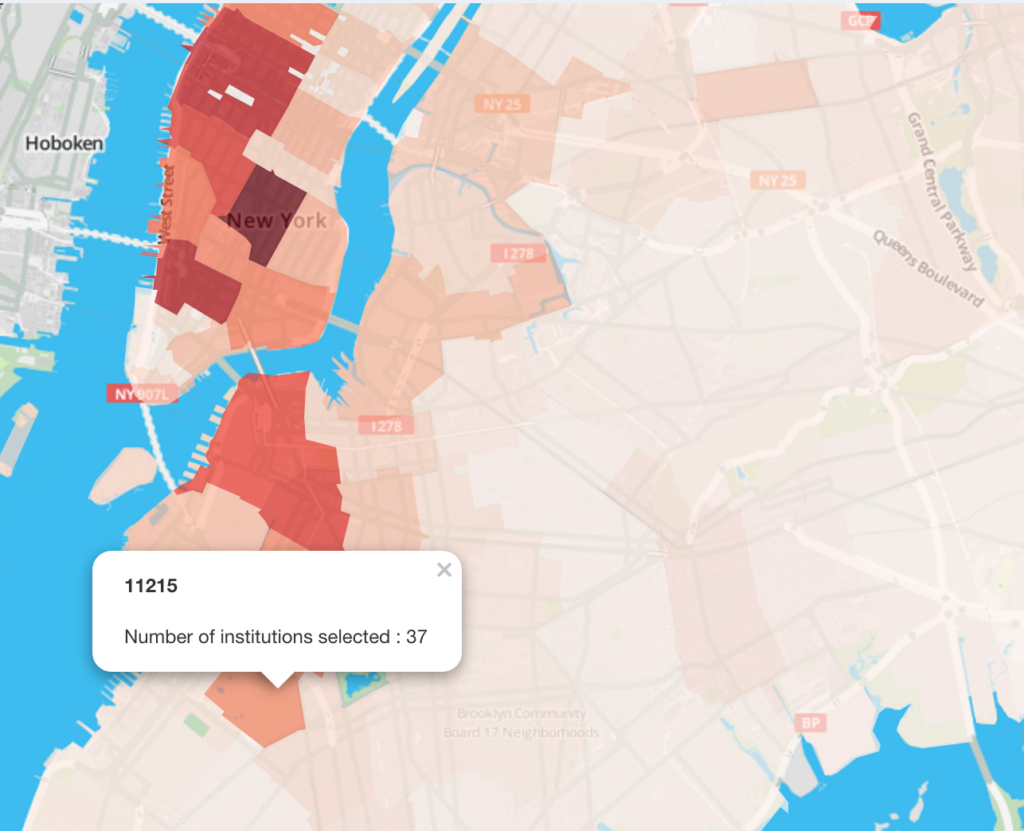Cultural Institutions of New York City
Posted by Rob Castellano
Updated: May 13, 2016

Contributed by Rob Castellano. He is currently in the NYC Data Science Academy 12 week full time Data Science Bootcamp program taking place between April 11th to July 1st, 2016. This post is based on his second class project - Shiny visualization (due on the 4th week of the program).
One of my favorite things about living in New York is its dazzling array of cultural institutions. With world-class theatre, museums, performance art, galleries, and even zoos, there is something for everyone. Even as someone who has lived in New York for several years (and in the surrounding area for even longer), these myriad of choices can be overwhelming--I can only imagine how tourists feel!
To help organize all that New York has to offer, I designed an app that helps users find the institutions that are of interest to them. This app was built to answer some of the following questions: What institutions are nearby? Where are the types of institutions I'm interested in? What neighborhoods are hubs of a given discipline? How can I get information about the institutions I'm interested in?
Have fun and explore using the app here!
Note: This app was built using R Shiny. All code can be found on GitHub.
The Data
The institutions in the app are all of those listed by the New York City Department of Cultural Affairs. Their directory is available via NYC Open Data. There are just under 2000 institutions that are grouped into 20 disciplines that include "Dance", "Museums", "Literature", and "Science". (A few institutions do not have a discipline listed.) All of the disciplines are shown below and serve as choices for some features of the app.
The App
The app has three main components that I will outline below.
Mapping cultural institutions
The first feature of the app is to plot institutions on an interactive map. The user can choose the disciplines he/she is interested in seeing. For example, in the image below we've plotted all Dance, Literature, Multi-Disciplinary Performing, and Museum institutions. One can use this feature of the app to explore the institutions in a given area and get the information about institutions nearby.
You can also click on a given institution to obtain its information.
Institutions by ZIP Code
The second component of the map displays information about the number of institutions by zip code. The user chooses the disciplines he/she is interested in and the app shows an interactive map of the number of institutions of those disciplines by zip code. The user can also choose whether to rank by the total number of institutions in the zip code or by number of institutions per square mile in the zip code by using the button in the upper right corner.
For example, below I've plotted institutions of all disciplines and mapped by total number of institutions. With New York having such a large number of institutions, this portion of the app enables one to get a more global view of patterns in the city.
One can also click on a zip code to get the exact number of institutions selected that it has. The zip code 11215 has 37 total institutions.
Institution search
The final component of the app is a simple search of all institutions. The user enters text and a table of all institutions that matches this text is returned. This can be used to search institutions by borough, name, or address, for instance. As an example, one can use this to search for opera institutions (which is not a designated discipline).
What Can Be Learned?
This app can be used to explore different aspects of culture in New York. Just zoom in on your neighborhoods (or you're friend's neighborhood if you're just visiting) and discover institutions you didn't even know existed.
The zip code map can be used to glean information about the city as a whole. By looking at the map of total number of all institutions by zip code we see that, unsurprisingly, Manhattan has the largest concentration of institutions. Brooklyn and Queens neighborhoods near the East River, such as Long Island City, Williamsburg, Downtown Brooklyn, and Park Slope, as well as the North Shore of Staten Island are also well represented. However, we can see that even zip codes in eastern Queens have over 1 institution per square mile.
The West Side of Manhattan has many more institutions than the East Side. I was surprised to see that despite being home to "Museum Mile" and some of New York's best known museums, the Upper East Side does not have as many institutions, or even museums, as other parts of Manhattan.
There is a lot more to learn from the information in this app. Just by exploring, one can learn things like the fact that Ditmas Park is home to several theatre institutions. I hope you find this post and app interesting. Please comment with any thoughts, suggestions, or insights you discover!
Rob Castellano
Rob recently received his Ph.D. in Mathematics from Columbia. His training as a pure mathematician has given him strong quantitative skills and experience in using creative problem solving techniques. He has experience conveying abstract concepts to both experts...
View all articlesTopics from this blog: R Data Visualization NYC NYC Open Data Student Works Shiny R Shiny





